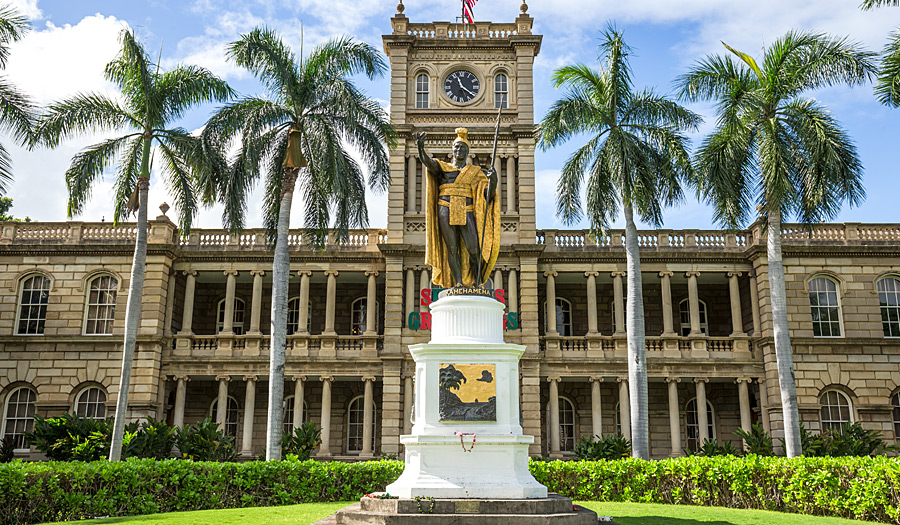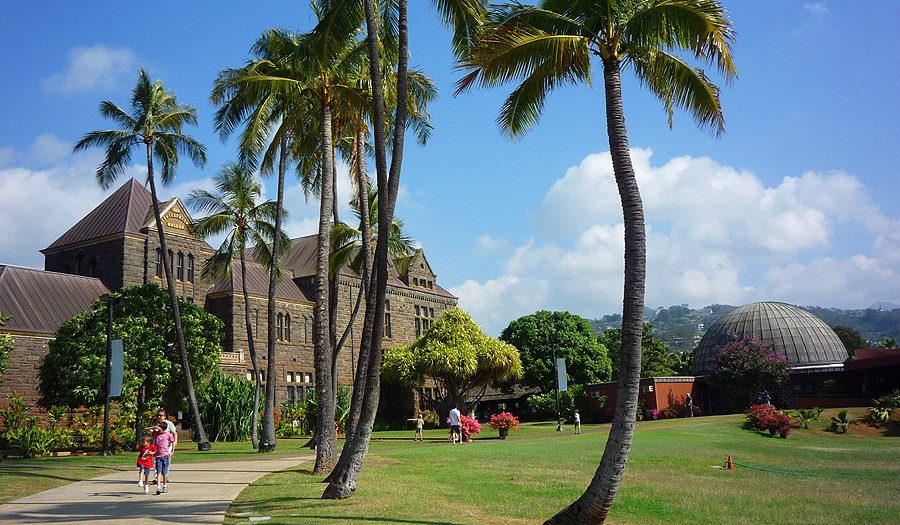Home to the State Capitol, Honolulu is the vibrant epicenter of Hawaii. Here you’ll find everything from historic landmarks and treasured monuments to world-class shopping and a flourishing arts and culture scene. Home to the majority of Oahu’s population, the sprawling city of Honolulu spreads throughout the southeastern shores of Oahu, from Pearl Harbor to Makapuu Point, encompassing world famous Waikiki.
Honolulu has it all. This is the home of some of Hawaii’s most historic places from Iolani Palace, the Kawaiahao Church, the Hawaiian Mission Houses Historic Site and Archives and the treasured artifacts of the Bishop Museum to iconic landmarks like the Aloha Tower, the King Kamehameha I Statue, the Duke Kahanamoku Statue and the historic Hawaii Theatre. Honolulu is also Hawaii’s hot spot for arts, culture and entertainment. From the nightlife, live music and fine dining of Waikiki to the art galleries and underground bars of the Chinatown arts district. Whether you’re looking for Hawaii’s finest museums, or Hawaii’s finest Hawaii Regional Cuisine chefs, the best resorts, festivals, and events, or just some fun things to do, you’ll find it all in Honolulu.
Hawaii Convention Center
The Hawai'i Convention Center (HCC) is a premier convention and exhibition center in Hawaii, located in Honolulu on the island of Oahu. The Hawaii Convention Center is the largest exhibition center of its type in the state. It is located directly to the west of the Waikiki district of Honolulu.
Located within walking distance of Waikiki, the Hawaii Convention Center is like no other in the world. Open to the outdoors – with terraces, lanais, courtyards, waterfalls, and fishponds – this remarkable facility combines the latest in cutting edge technology with authentic Hawaiian ambience. Our cultural diversity and legendary spirit of aloha encourage attendees to see the world in a new light, so it’s no surprise that people accomplish more when they meet here. Best of all, the warmth of Hawaii and its people continue to inspire, long after meetings have ended.
Sand Island
Sand Island State Recreation Area offers weekends-only shoreline camping within a heavily industrialized area very close to the urban core of Honolulu and the flight path of the Honolulu International Airport. This park is also adjacent to the Sand Island Off Highway Vehicle (OHV) day use riding area – which contains tracks and trails for motorized OHV’s and non-motorized BMX bikes.
Sand Island is an arid, urban coastal park which offers picnicking, camping, walking, shore fishing and board surfing. It fronts a small sand beach and has good views of Honolulu Harbor and ocean sunsets.
Iolani Palace

A national historic landmark and the only official state residence of royalty in the United States, Downtown Honolulu’s Iolani Palace was the official residence of the Hawaiian Kingdom’s last two monarchs from 1882 to 1893: King Kalakaua and his sister and successor, Queen Liliuokalani.
The palace was a symbol of promise for the Hawaiian Kingdom built by King David Kalakaua, “The Merrie Monarch.” Influenced by European architectural styles, this royal residence included Hawaii’s first electric light system, flush toilets and intra-house telephones. The rich interior features a beautiful koa staircase, dramatic portraits of Hawaiian royalty, ornate furniture and royal gifts and ornaments from around the world.
In 1893, a provisional U.S. government was established after opposition forces overthrew the Hawaiian monarchy. The Hawaiian Islands were eventually annexed as a United States Territory in 1898. Hawaii became the 50th state in 1959 and during this time Iolani Palace was used as the capitol building until 1968. After falling into disrepair over the years, the Iolani Palace was opened to the public in 1978 after an extensive renovation.
Tour through this American Florentine-style palace’s throne room, reception and dining room and envision the magnificent state dinners and balls held here. View the private living quarters of the royal family and listen to the tragic story of Liliuokalani’s imprisonment in an upstairs bedroom following the overthrow. On the basement level view the ancient regalia of Hawaiian royalty from swords and precious jewelry to the two golden crowns of the King and Queen. On the spacious grounds of the palace, see the Iolani Coronation Pavilion, where in 1883 Kalakaua was crowned king.
Also note that Iolani Palace sits in the center of a vital area that is worth a walking tour. Across South King Street you’ll find Aliiolani Hale and the King Kamehameha I statue. Right behind Iolani Palace is the State Capitol building and Washington Place, home to the governor. To the east are the historic Kawaiahao Church, Honolulu Hale (home to the City Council and offices of the Mayor) and the Hawaiian Mission Houses Historic Sites and Archives. To the west you’ll discover the Hawaii State Art Museum as well as Oahu’s main financial and arts district in Downtown Honolulu and Chinatown.
You can take a guided tour or a self-guided audio tour of the Palace Tuesday through Saturday. If you’re facing the Palace, the ticket office is to the left on the State Capitol side of the building. One of Oahu’s most important historical places, Iolani Palace plays an integral part in understanding the history and culture of Hawaii. Learn more about the Iolani Palace.
Downtown

Downtown Honolulu is home to some of Oahu’s most historic places. Next to the skyscrapers of the island’s main business district you’ll find important landmarks like the Iolani Palace, the King Kamehameha I statue, the Kawaiahao Church and the Aloha Tower. This area is also the seat of Hawaii’s government, home to the Hawaii State Capitol, Washington Place (the governor’s mansion) and Honolulu Hale (Honolulu’s City Hall). Clustered within blocks of each other, it’s easy to take a walking tour of these important cultural landmarks and architectural wonders.
Located on the western hem of Honolulu’s financial district, Chinatown’s historic buildings are home to a hodgepodge of shops, herbalists, lei makers, antique dealers, temples, bars and restaurants. By day, explore Chinatown’s bustling markets like the Maunakea Marketplace or the Oahu Market. Here you’ll find exotic fruits, seafood and curiosities like the “thousand-year old egg.” Incredible temples like the Izumo Taishakyo Mission Shrine and the Kuan Yin Temple transport you to historic Japan and China. And when you’re hungry, Chinatown’s eclectic restaurants serve everything from dim sum (Chinese dumplings) to Eurasian, Vietnamese, Malaysian and even Cuban and French fare.
This is also the epicenter of Oahu’s arts scene. Take the Chinatown art walk along and around Nuuanu and Bethel Street during the monthly First Friday festivities, the best time to experience all the area has to offer. In fact, Chinatown is a hot spot for Oahu nightlife. Home to the historic Hawaii Theatre for live music and shows, you can find some of Hawaii’s hottest underground bars, clubs and restaurants in the weathered lofts and buildings of urban Chinatown after dark.
Aloha Tower

Located on the Honolulu Harbor in Downtown Honolulu, about 15 minutes west of Waikiki, Aloha Tower is an iconic symbol of Hawaii. Built in September of 1926, this was the tallest building in the islands for four decades and its clock was one of the largest in the United States. The tower stood as a welcoming beacon for visitors since travel to Oahu was done entirely by sea. Duke Kahanamoku set his first swimming world record here at Pier 7 and the wharf was also known for Boat Days, a lively celebration to welcome the arrival of visiting ships.
Today, Aloha Tower is still a docking port for Oahu’s cruise ships, with this historic place currently undergoing renovations. You can still enjoy an ocean-view lunch, listen to live music at night, and walk just a couple of blocks to Chinatown’s art district. You can also go up to the Observation Deck, located on the 10th floor of Aloha Tower to find the perfect spot for beautiful views of the harbor on one side and the cityscape of Honolulu on the other.
Bishop Museum

Honolulu's Bishop Museum is Hawaii's largest museum dedicated to studying and preserving the history of Hawaii and the Pacific. Originally designed to house the extensive collection of Hawaiian artifacts and royal family heirlooms of Princess Bernice Pauahi Bishop, a descendent of King Kamehameha I, the museum is now the premier natural and cultural history institution in the Pacific. One of Oahu’s most historic places, the museum holds millions of artifacts, documents and photos about Hawaii and other Polynesian cultures.
Visit the newly renovated Hawaiian Hall, which immerses you in Native Hawaiian culture and history by showcasing a variety of important artifacts. In the planetarium, kids can learn how voyagers navigated the Pacific using the stars. In the Science Adventure Center, children can see Hawaii’s unique natural environment like never before through a variety of interactive exhibits.
Note that the museum is closed every Tuesday and on Christmas Day (December 25th), but is open year round with regular hours from 9 a.m. to 5 p.m. Learn more about the Bishop Museum.
